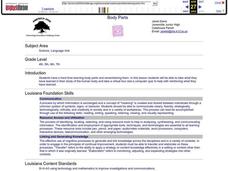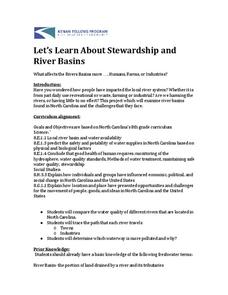Homo Erectus Teacher Resources
Find Homo Erectus lesson plans and worksheets
Showing 23,160 resources
Curated OER
Human Body Parts
Students create body cutouts of themselves and label specific internal and external organs/parts that are covered in class in this exciting lesson on Human Anatomy. Digital cameras and pictures of various internal organs are required.
Curated OER
The Human Brain
In this biology worksheet, learners color a labeled diagram of the human brain using the colors designated in the chart below the diagram. They record the function of each portion of the brain in the same chart. They list the functions...
Curated OER
Climate Change
Rising sea levels, strong storms, melting ice ... who or what is to blame? Scholars browse the website in preparation for a class discussion or debate about whether human activity is causing climate change. They gain a balanced...
Advocates for Human Rights
The Rights of Immigrants in the United States
Based on their understanding of the Universal Declaration of Human Rights and the Rights of Migrants in the United States, groups adopt a human rights perspective and analyze media reports to evaluate how the US is addressing the...
Macat
An Introduction to Thomas Malthus' An Essay on the Principle of Population
Can human population ever exceed its ability to produce food? High schoolers watch a short overview of Thomas Malthus's An Essay on the Principle of Population to learn more about the subsistence level of the human population,...
Be Smart
Why Are Some People Left-Handed?
Most animals that show a paw preference are split 50/50 with half of the population preferring one side and the other half preferring the other, yet in humans only 10 percent are left-handed. The video explains what part of the brain...
Advocates for Human Rights
Refugees and Asylum Seekers
To gain a deeper understanding of the plight of refugees and asylum seekers, class members read stories written from the point of view of an emigrant, map the individual's journey, and note the human rights affected by each stage of the...
Chicago Botanic Garden
Introducing Ecosystem Services
Purifying air and water, providing soil in which to grow crops, and moving water through its natural cycle are all services an ecosystem provides that benefit humans. Lesson four in a series lets learners explore and discuss the value of...
Science Matters
That’s An Otter Story
Young scientists discover how sea otters' habitats have changed due to human impact. Through conversation, video observation, and story reading, scholars identify how human interactions change a specific ecosystem in both positive and...
Howard Hughes Medical Institute
Ocean Acidification
Human impacts on the environment can sometimes be difficult to measure, especially under water! An activity centered on ocean acidification gives science scholars the opportunity to examine the effects of carbon dioxide on marine life....
Kenan Fellows
The Little Stuff Can Make a Big Difference
Great things come in small packages! What better way to illustrate this point than a week-long look at nanotechnology? Earth science scholars explore water quality issues through lab activities, then research new innovations in nanotech...
California Academy of Science
Solutions to Human Impacts
The phrase think globally, act locally inspires scholars to address pollution. After learning about invasive species, nutrient pollution, and dead zones, discussion questions help scholars link the concepts. They then apply knowledge of...
Curated OER
When Is It O.K. to Replace Human Limbs With Technology?
Today's blog topic is robotic limb replacement for amputees. Upper graders read the related article and argument, then compose a blog response that addresses the questions provided. This is a great way to get kids thinking about ethics,...
TED-Ed
On Spaghetti Sauce
"In embracing the diversity of human beings, we will find a sure way to human happiness." Watch as Tipping Point author Malcolm Gladwell delves into work of acclaimed psychophysicist Howard Moskowitz and the evolution of the food...
NOAA
I Didn’t Do It…Did I?: Make Your Own Greenhouse Effect
How do greenhouse gases affect the climate on Earth? Pupils explore the concept by first building their own apparatuses to model the greenhouse effect. Then, they record data to measure temperature change and determine...
American Museum of Natural History
Differentiate! The Stem Cell Card Game
Let the games grow. Groups play a card game to grow cells. Players start growing cells from stem cells to create specialized cells in the human body. Learners use full-grown cells from the human body to create stem cells in the lab to...
Curated OER
Body Parts
Students discuss the importance of systems of the human body and ways each has its own function while relying on the others. Students work in groups to research their assigned system. They complete a report. Students take virtual tours...
Curated OER
Eyes On Me
Students investigate the human eye. In this biology lesson, students read the book Look At Your Eyes and locate the various parts of their eye. Students play the game "I Spy."
TED-Ed
What Did Dogs Teach Humans About Diabetes? diseases
For thousands of years people recognized the symptoms of diabetes, but it wasn't until the early twentieth century that a treatment was finally discovered. This video explores the Nobel Prize winning scientists' whose work with...
Florida Department of Environmental Protection
Water's Journey Expedition
Step into a scientist's shoes to go online and discover the Florida Springs Expedition, and participate in two activities focusing on how humans impact the environment. The first activity asks scholars to summarize the six...
Advocates for Human Rights
U.S. Immigration Policy
The United States Immigration Policy is incredibly complex. To gain a deeper understanding of the criteria, quotas, preferences, and categories of immigrants admitted to the US, class members engage in a role playing activity that...
Kenan Fellows
Let's Learn About Stewardship and River Basins
What does it mean to be a good steward? Middle school environmentalists learn to care for their state's waterways through research, a guest speaker, and poster activity. Groups must locate and learn more about a river basin and the human...
Howard Hughes Medical Institute
Human Embryonic Development
At what point in the fertilization process do stem cells turn into an embryo? Viewers observe the development of an embryo from egg to fertilization to development into a fetus. The narrator stresses the role of cell division,...
Curated OER
Harvest the Facts
Students discover heath problems caused by tobacco. In this human health lesson plan, students identify the many diseases tobacco use causes and how to prevent such diseases. Students investigate the organs in the human body...
Other popular searches
- Early Man
- Early Humans
- Timeline of Early Man
- Environment Humans
- Effects on Humans
- Apes and Humans
- Impact on Humans
- African History of Humans
- Early Man Neanderthal
- Nervous System in Humans
- Humans and Environment
- First Humans

























